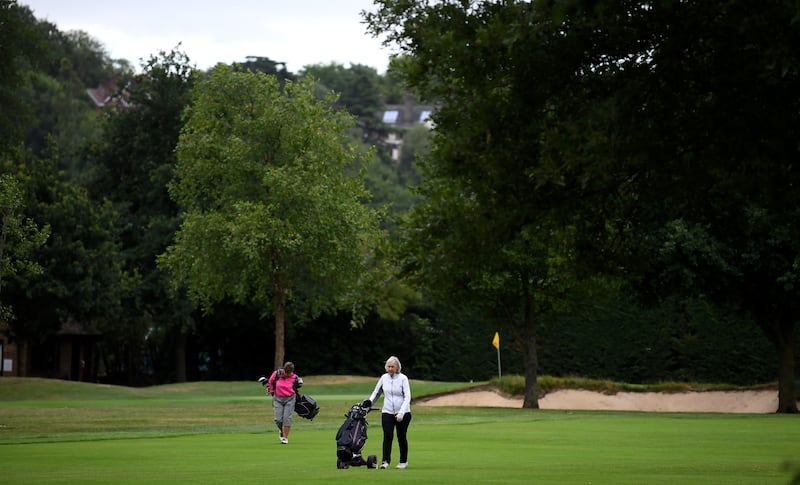When walking in London’s Hyde Park you cannot escape monuments. In one of the city’s longest uninterrupted vistas looking from Kensington Palace over the Round Pond and towards the north bank of the Long Water part of the Serpentine lake, a semiabstract sculpture by the artist Henry Moore stands six metres high.
Towards Knightsbridge, there’s the Albert Memorial and Albert Hall and, closer to the water the Peter Pan, statue. Not far from there the feral green parrots of London fly down from the trees and feed from people’s hands.
In another section adjacent to Park Lane, they had Pink and Guns N’ Roses playing at the end of June, and in the first few weeks of July it’s Lana Del Ray, Bruce Springsteen and Billy Joel. You can listen to the bands doing a drive-through morning session while you are having coffee at the lido.
It is still part of the English psych to think big and in a city as financially muscular as London, huge projects can be made to work. They can sweat the London asset, its scale, its income and its sense of itself and where it stands in the world.
READ MORE
Wimbledon is part of that thinking and is also doing its own kind of monument building, although that is not the word they would care to use as it suggests something that is unmoving and part of the past, when their idea is precisely the opposite. They are far from static and have set their sights on a state-of-the-art tennis development that is good for “London and Britain”.
The grand plan is to extend the current site, a long, thin piece of ground that runs to a point. A road called Church Road divides Wimbledon from what was once the Wimbledon Park Golf Club, which the tennis club have already bought. They see it as a future-proofing decision to upgrade and migrate into the golf land to maintain their position as no less than the best tennis facility in the world. It is, in a sense, part of the tennis arms race.
Nor is it just a golf club, the proposed development is on the lands of a great park originally designed by the famous landscape architect Capability Brown, who lists Blenheim Palace, Warwick Castle and Milton Abbey among his works.
Monumental in its scale, the footprint of the new complex is almost three times the size of the current Wimbledon site. Far from stuffy and time-honoured, it represents bold thinking. Then again, the All England Club has always been a set of contradictions.
Perceived as an establishment organisation with a strongly classical feel and wedded to the history of the tournament and the champions that have passed through, the other side of its boardroom character is a hyper-modern body that is aggressively innovative.

The drive comes from its current standing as the top Grand Slam event. Anecdotally, most of the players who are asked the question say Wimbledon is the most important of the four Grand Slams, although it is played in a narrow window during an extremely short grass-court season.
The ivy growing up the outside walls of the Centre Court is a deliberate play on the idea of being long established. The club works hard to hold on to an idea of the past as a point of difference and character-defining. It celebrates its age as the oldest in the world but never stands still.
For easy consumption of the ‘big idea’ they use typically quaint language. As it stands, Wimbledon is tennis in an English garden. They want people to think of Wimbledon as tennis in an English parkland with an emphasis on the English.
With a new 8,000-seat stadium, called the Parkland Show Court, the build would increase the competition’s daily spectator capacity from 42,000 to 50,000 and the number of seats available to the tournament to 43,842, with Centre Court remaining the jewel in the crown with an almost 15,000 capacity.
The club bought the land from Merton Council in 1993 for £5.1 million and, in 2018, offered the golf club £65 million to end its lease early. The deal was accepted, with every member of the club, including television celebrities such as Ant and Dec, receiving £85,000 in exchange for finding a new place to play golf.
Planning permission hearings take place later this year. If they go well, building could begin in the early 2030s in what would be one of the biggest redevelopments in London since the 2012 Olympic Games. There have already been objections and it is anticipated a considerable number of local people will argue against the proposal.
The new courts mean that the entire qualifying tournament can be played on site. There will also be extra parkland space and a boardwalk is planned around the lake in Wimbledon Park. Seven of the grass courts will be available for community use after the competition.
[ 1890: The year that Ireland ruled at the All England ClubOpens in new window ]
[ Wimbledon to introduce AI-powered commentary to coverage this yearOpens in new window ]
The timeline depends on how planning permission pans out. But the club hopes some of the community access will open by 2026, with the grass courts completed by 2027 and in use for the qualifiers and championships by 2029 after they have matured. The Parkland Show Court should be complete by the early 2030s.
A monument to tennis, something at which the city has become quite good.
















